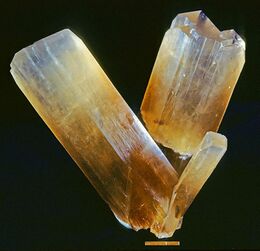Chemistry:Borax (mineral)
From HandWiki
Short description: Borate mineral
| Borax | |
|---|---|
 Borax from the Kramer Borate deposit, Boron, Kern Co, California, USA | |
| General | |
| Category | Nesoborate |
| Formula (repeating unit) | Na2B4O5(OH)4·8H2O |
| Strunz classification | 6.DA.10 |
| Crystal system | Monoclinic |
| Crystal class | Prismatic (2/m) (same H-M symbol) |
| Space group | C2/c (no. 15) |
| Unit cell | a = 11.8790(2) Å, b = 10.6440(2) Å, c = 12.2012(2) Å; β = 106.617(1)°; Z = 4 |
| Identification | |
| Color | Colorless or white |
| Crystal habit | As prismatic crystals or as massive encrustations |
| Twinning | Rare on {100} |
| Cleavage | Perfect on {100}, less perfect on {100}, very poor on {010} |
| Fracture | Conchoidal |
| Mohs scale hardness | 2 to 2.5 |
| |re|er}} | Vitreous to resinous to earthy |
| Streak | White |
| Diaphaneity | Translucent to opaque |
| Specific gravity | 1.715 |
| Optical properties | Biaxial (-) |
| Refractive index | nα = 1.4466 nβ = 1.4687 nγ = 1.4717 |
| Fusibility | 1.5 |
| Diagnostic features | Froths on heating, producing a yellow flame |
| Solubility | Soluble in water |
| References | [1][2][3][4] |
Borax first reached Western civilization as tincal mined from deposits in Tibet.[4] The term borax comes from the Arabic bauraq, meaning white.[2]
Occurrences
The most extensive deposits are in Kirka, Turkey. Borax is also mined in the Andes Mountains of Argentina , Bolivia, and Chile . However, the greatest production is from the deposits in California.[4]
Uses
Natural occurrences of the mineral are an important source of commercial borax, which is used for the manufacture of glass fibers, in cleaning agents, as an antiseptic, and as a flux in metallurgy and solvent for metal oxides.[4]
See also
References
- ↑ Anthony, John W.; Bideaux, Richard A.; Bladh, Kenneth W.; Nichols, Monte C. (2005). "Borax". http://www.handbookofmineralogy.org/pdfs/borax.pdf.
- ↑ 2.0 2.1 Borax, MinDat.org, http://www.mindat.org/show.php?id=722
- ↑ Sinkankas, John (1964). Mineralogy for amateurs.. Princeton, N.J.: Van Nostrand. pp. 382–383. ISBN 0442276249.
- ↑ 4.0 4.1 4.2 4.3 Klein, Cornelis; Hurlbut, Cornelius S. Jr. (1993). Manual of mineralogy: (after James D. Dana) (21st ed.). New York: Wiley. pp. 421–422. ISBN 047157452X.
- ↑ Warr, L.N. (2021). "IMA–CNMNC approved mineral symbols". Mineralogical Magazine 85 (3): 291–320. doi:10.1180/mgm.2021.43. Bibcode: 2021MinM...85..291W.
 |

